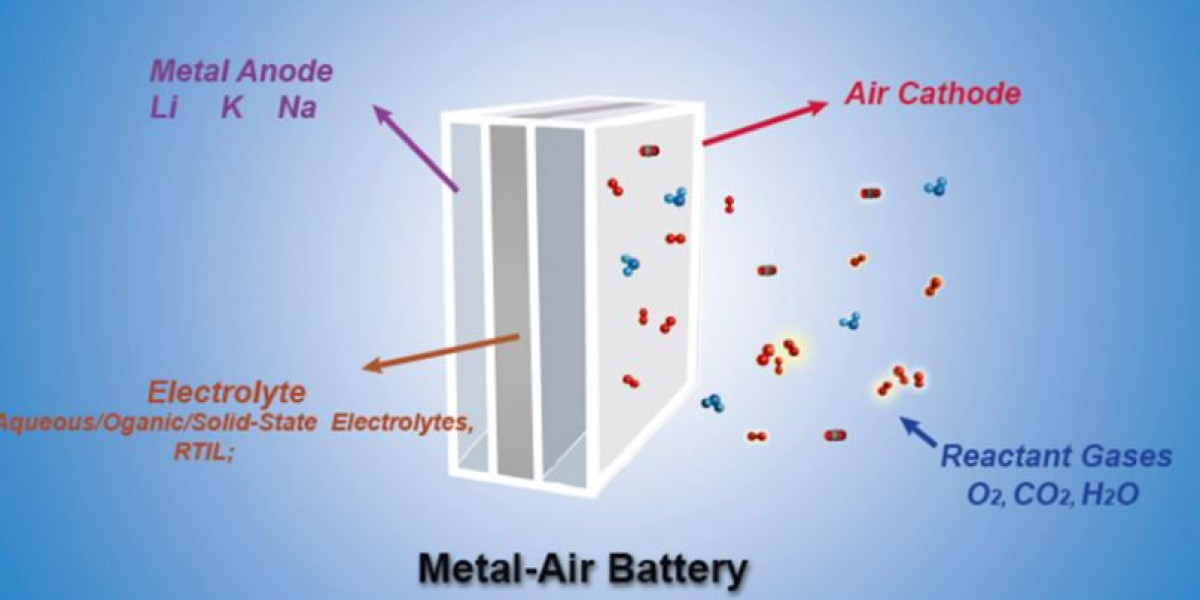As the world shifts toward sustainable energy and electrification, the demand for high-capacity, lightweight, and efficient batteries has never been greater. Among the promising innovations in energy storage, metal-air batteries stand out for their exceptional energy density and eco-friendliness. This cutting-edge technology is reshaping the landscape of electric vehicles (EVs), portable electronics, and grid storage, fueling growth in the global metal-air battery market.
What Are Metal-Air Batteries?
Metal-air batteries generate electricity through the oxidation of a metal (such as lithium, zinc, aluminum, or iron) with oxygen from the air. Unlike conventional batteries, they don’t require an internal oxidizer, making them lighter and potentially much more energy-dense.
Common types include:
- Zinc-Air Batteries – Widely used in hearing aids and backup power systems.
- Lithium-Air Batteries – Known for their high energy potential, targeted at EV applications.
- Aluminum-Air and Iron-Air Batteries – Under active research for scalable energy storage and cost-effective transportation.
Market Trends and Drivers
The global metal-air battery market is on a robust growth trajectory, driven by several key factors:
- Rising Demand for Electric Vehicles (EVs): As automakers look for alternatives to lithium-ion batteries, metal-air technologies offer longer ranges with lighter weight, making them highly attractive for next-gen EVs.
- Grid Energy Storage Needs: Renewable energy sources like solar and wind require reliable storage solutions. Metal-air batteries, especially iron-air, are being explored for long-duration energy storage due to their affordability and scalability.
- Technological Advancements: Breakthroughs in electrolytes, air cathodes, and metal anodes are addressing earlier limitations like short cycle life and low rechargeability.
- Environmental Concerns: Metal-air batteries are more environmentally benign compared to conventional options, with the potential to use abundant and recyclable materials.
Challenges
Despite their promise, metal-air batteries face several hurdles:
- Rechargeability Issues: Many metal-air systems, particularly lithium-air, suffer from limited recharge cycles and degradation over time.
- Air Electrode Stability: Maintaining the performance of air cathodes in ambient conditions is a major technical challenge.
- Cost and Infrastructure: Some variants require new manufacturing processes or infrastructure development to scale.
Market Outlook
The Metal-Air Battery Market is expected to register a CAGR of 14.6% from 2025 to 2031, with a market size expanding from US$ XX million in 2024 to US$ XX Million by 2031.
Asia-Pacific is anticipated to dominate the market, driven by rapid industrialization, EV adoption, and government initiatives supporting green technologies. North America and Europe are also investing heavily in research and pilot projects.
Startups and major players alike—such as Phinergy, Zinc8 Energy Solutions, and Form Energy—are leading innovations and attracting venture capital. Collaborations with automakers and utility companies are further accelerating development.
Get the Sample: - https://www.theinsightpartners.com/sample/TIPRE00011816
Conclusion
Metal-air batteries represent a compelling leap forward in the quest for clean, high-capacity energy storage. While technical and economic challenges remain, continued R&D and strategic investments are steadily unlocking their potential. As the world edges closer to a carbon-neutral future, metal-air batteries could play a pivotal role in powering everything from electric cars to entire cities.








